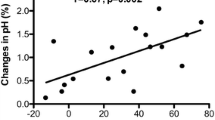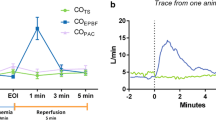Abstract
Isocapnic hyperventilation (ICHV) is occasionally used to maintain the end-expired CO2 partial pressure (PETCO2) when the inspired CO2 (PICO2) rises. Whether maintaining PETCO2 with ICHV during an increase of the PICO2 also maintains arterial PCO2 (PaCO2) remains poorly documented. 12 ASA PS I–II subjects undergoing a robot-assisted radical prostatectomy (RARP) (n = 11) or cystectomy (n = 1) under general endotracheal anesthesia with sevoflurane in O2/air (40% inspired O2) were enrolled. PICO2 was sequentially increased from 0 to 0.5, 1.0, 1.5 and 2% by adding CO2 to the inspiratory limb of the circle system, while increasing ventilation to a target PETCO2 of 4.7–4.9% by adjusting respiratory rate during controlled mechanical ventilation. Pa-ETCO2 gradients were determined after a 15 min equilibration period at each PICO2 level and compared using ANOVA. Mean (standard deviation) age, height, and weight were 66 (6) years, 171 (6) cm, and 75 (8) kg, respectively. Capnograms were normal and hemodynamic parameters remained stable. PETCO2 could be maintained within 4.7–4.9% in all subjects at all times except in 1 subject with 1.5% PICO2 and 5 subjects with 2.0% PICO2; data from the one subject in whom both 1.5 and 2.0% PICO2 resulted in PETCO2 > 5.1% were excluded from analysis. Pa-ETCO2 gradients did not change when PICO2 increased. The effect of a modest rise of PICO2 up to 1.5% on PETCO2 during RARP can be readily overcome by increasing ventilation without altering the Pa-ETCO2 gradients. At higher PICO2, airway pressures may become a limiting factor, which requires further study.


Similar content being viewed by others
Data availability
Any party petitioning the IRB and receiving approval is welcome to obtain the raw data.
Code availability
N/A.
References
Hallén K, Jildenstål P, Stenqvist O, Ricksten SE, Lindgren S. Evaluation of a method for isocapnic hyperventilation: a clinical pilot trial. Acta Anaesthesiol Scand. 2018;62(2):186–95. https://doi.org/10.1111/aas.13008.
Bashraheel MK, Eerlings SA, De Wolf AM, Neyrinck A, Van de Velde M, Vandenbroucke G, Carette R, Feldman J, Hendrickx J. Memsorb™, a novel CO2 removal device part I: in vitro performance with the Zeus IE®. J Clin Monit Comput. 2022. https://doi.org/10.1007/s10877-021-00802-0.
Eerlings SA, Bashraheel MK, De Wolf AM, et al. Memsorb™, a novel CO2 removal device part II: in vivo performance with the Zeus IE®. J Clin Monit Comput. 2022. https://doi.org/10.1007/s10877-022-00808-2.
Hendrickx JF, De Ridder SP, Dehouwer A, Carette R, De Cooman S, De Wolf AM. In vitro performance of prefilled CO2 absorbers with the Aisys®. J Clin Monit Comput. 2016;30(2):193–202. https://doi.org/10.1007/s10877-015-9699-2.
Acknowledgements
N/A.
Funding
The study was funded by intradepartmental means only, and was limited to the cost of arterial blood gas analysis.
Author information
Authors and Affiliations
Contributions
All authors contributed to the study conception and design. All authors read and approved the final manuscript.
Corresponding author
Ethics declarations
Conflict of interest
Jan Hendrickx has received lecture support, travel reimbursements, equipment loans, consulting fees and/or meeting organizational support from a number of companies involved with inhaled agent delivery (alphabetically): AbbVie, Acertys, Air Liquide, Allied Healthcare, Armstrong Medical, Baxter, Dräger, GE, Hospithera, Heinen und Löwenstein, Intersurgical, Maquet, MDMS, MEDEC, Micropore, Molecular, NWS, Philips, Quantum Medical. The other authors declare that they have no conflict of interest.
Ethical approval
Approval was granted by the Ethics Committee of OLV hospital. This study was performed in line with the principles of the Declaration of Helsinki. Belgian Registration Number B126202042718; Local Hospital Number 2020/009.
Consent to participate
Informed consent was obtained from all individual participants included in the study.
Additional information
Publisher's Note
Springer Nature remains neutral with regard to jurisdictional claims in published maps and institutional affiliations.
Appendix A
Appendix A
The relationship between ventilation, CO2 elimination, PICO2 and PETCO2 can be derived by considering CO2 mass balances in the lung: the amount of exhaled CO2 has to be the same as the amount of CO2 entering the lungs (See Eq. 1). If it is assumed that in- and expired MV are the same, if fVD is defined as apparatus plus anatomical dead space, and if partial pressures in the formula below are expressed in fraction of 1 atm, these mass balances are described as:

Equation 1. CO2 mass balances in the lung.
The amount of exhaled CO2 (= amount leaving the Y-piece of the circle breathing system; left hand side of equation) is the sum of the amount contained in the apparatus and anatomical dead space (with concentration PICO2, expressed in fraction) plus the part of exhaled MV that does take place in gas exchange (with concentration PETCO2, expressed in fraction). The amount of CO2 entering the lungs (right hand side of equation) is the sum of VCO2 and the amount of inhaled CO2. VCO2 is the amount of CO2 entering the alveoli from the mixed venous blood, which itself is the sum of endogenous CO2 production and any exogenous CO2 load (e.g. resorption from a capnopneumoperitoneum). The amount of inhaled CO2 is the product of MV and PICO2, expressed in fraction. Equation [Eq. 1] can be rearranged as follows, starting by dividing all parameters by MV:
Rearranging Eq. 2 explains how ventilation has to be adjusted to keep PETCO2 constant (isocapnia) when PICO2 increases:
When the increase in PICO2 is small (e.g. 0.1%), it can be ignored because the additive effect of a rise of PICO2 of that order of magnitude on PETCO2 is clinically irrelevant. The effect of a modest rise in PICO2 on PETCO2 can be curtailed by increasing MV. The extent to which MV has to be increased to maintain PETCO2 with various PICO2 concentrations can be derived by rearranging the above equation:
Equation 4 illustrates that the increase in MV required to maintain PETCO2 varies in a non-linear manner with PICO2.
Rights and permissions
About this article
Cite this article
Jouwena, J., Eerlings, S.A., De Wolf, A.M. et al. Arterial to end-tidal CO2 gradients during isocapnic hyperventilation. J Clin Monit Comput 37, 311–317 (2023). https://doi.org/10.1007/s10877-022-00893-3
Received:
Accepted:
Published:
Issue Date:
DOI: https://doi.org/10.1007/s10877-022-00893-3




